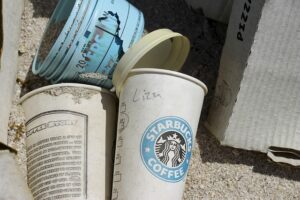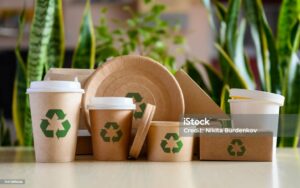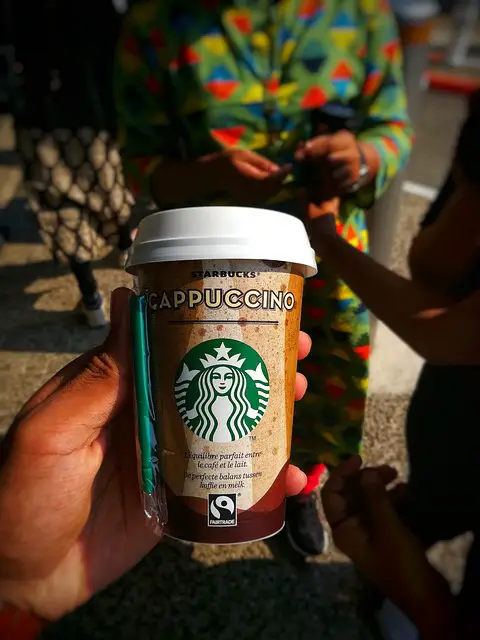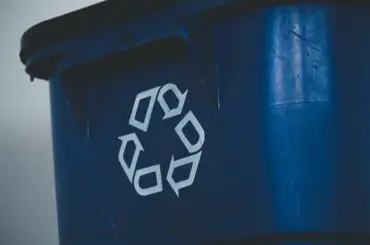Contents
Recycle Starbucks cups.
Introduction
In the bustling world of coffee aficionados and on-the-go caffeine enthusiasts, the iconic green and white cups of Starbucks have become synonymous with that much-needed daily jolt. But as our world grapples with growing concerns about environmental sustainability, a pressing question looms: “Can you recycle Starbucks cups?”

Composition of Starbucks Cups
Starbucks cups, with their familiar green logo and inviting aroma of freshly brewed coffee, are a common sight in the hands of people worldwide. However, understanding what goes into making these cups is crucial when considering their recyclability. Let’s delve into the composition of Starbucks cups, focusing on the materials used and the challenges posed by the plastic components.
Materials Used in Starbucks Cups:
At first glance, Starbucks cups may appear to be entirely made of paper. While paper is a significant component, there’s more to the story:
Paper: The main body of Starbucks cups is indeed crafted from paper. This paper is typically sourced from sustainable forestry practices, aligning with Starbucks’ commitment to environmental responsibility.
Plastic Lining: Here’s where the complexity arises. To make the cups waterproof and prevent them from leaking, Starbucks cups are lined with a thin layer of plastic. This plastic lining is what poses challenges for recycling efforts.
Challenges Posed by the Plastic Lining:
The plastic lining of Starbucks cups, while essential for practical use, presents hurdles when it comes to recycling:
Separation Difficulty: Recycling facilities are equipped to handle specific materials but may struggle to effectively separate the plastic lining from the paper. This can hinder recycling efforts, as the two materials must be processed separately.
Contamination Concerns: The plastic lining can complicate the recycling process and potentially contaminate other paper products in the recycling stream. Contamination can result in lower-quality recycled materials.
Recycling Facility Capabilities: The ability to recycle Starbucks cups depends largely on the capabilities of local recycling facilities. Not all facilities are equipped to handle items with plastic linings, which can lead to cups being diverted to landfills.
Innovations in Recycling: Some regions have implemented innovative recycling technologies that can effectively separate and process Starbucks cups. These efforts represent a step forward in addressing the challenges posed by the plastic lining.
Understanding the composition of Starbucks cups, with their paper bodies and plastic linings, provides valuable insights into the complexities of recycling them. While the paper component is recyclable, the presence of the plastic lining necessitates a more nuanced approach to recycling these ubiquitous coffee containers. In the next sections, we’ll explore how and where Starbucks cups can be recycled and offer tips for eco-friendly coffee consumption.
Check with Your Local Recycling Program
When it comes to recycling Starbucks cups, it’s essential to recognize that recycling capabilities can vary significantly from one location to another. What is accepted in one city may not be processed the same way in another. Therefore, it’s crucial to understand the nuances of your local recycling program to make informed decisions about Starbucks cup disposal. Here’s how you can navigate this variation:
Emphasize the Variation in Recycling Capabilities:
Regional Differences: Recycling facilities and programs are often managed at the regional or municipal level. As a result, the recycling capabilities in your city or town can differ from those in neighboring areas.
Technological Advancements: Some regions may have invested in advanced recycling technologies that can effectively process Starbucks cups, including separating the paper from the plastic lining.
Local Regulations: Local recycling regulations and policies can also impact what can be recycled. These regulations may change over time, so staying informed is crucial.
Advise Readers to Check with Their Local Recycling Programs:
Given the disparities in recycling capabilities, it’s wise to advise readers to check with their local recycling programs for specific guidelines on Starbucks cup recycling. Here’s how they can do that:
Visit the Recycling Program Website: Many municipalities and regions have dedicated websites that provide detailed information on recycling guidelines. Readers can visit these websites to find information specific to their area.
Contact Local Authorities: Local government agencies, such as the Department of Sanitation or Environmental Services, often handle recycling programs. Readers can contact these authorities directly via phone or email to inquire about Starbucks cup recycling in their locality.
Use Online Tools: Some recycling programs offer online tools or search features that allow residents to enter their zip code or address to access tailored recycling guidelines and information.
Provide Information on How to Contact Local Recycling Authorities:
To facilitate readers’ efforts in checking with their local recycling programs, you can offer contact information for relevant local authorities. This might include phone numbers, email addresses, or website URLs for easy reference.
By encouraging readers to investigate their local recycling options and guidelines, you empower them to make environmentally responsible choices when it comes to Starbucks cups and other recyclable materials. Understanding and following local recycling procedures is a crucial step in contributing to a more sustainable future.
Separating Components
When it comes to recycling Starbucks cups, one effective way to aid the recycling process and minimize environmental impact is by separating the plastic lids from the paper cups. This practice not only makes recycling more efficient but also aligns with local guidelines for responsible waste disposal. Let’s explore the concept of separating components and why it’s so essential in Starbucks cup recycling.
Explaining the Concept of Separating Plastic Lids from Paper Cups:
Two Distinct Materials: Starbucks cups are composed of two distinct materials—the paper cup itself and the plastic lid. These materials have different recycling requirements and processes.
Paper Cup: The main body of the Starbucks cup is typically made of paper, which is recyclable. Paper recycling involves breaking down the fibers and reusing them to create new paper products.
Plastic Lid: The lid, on the other hand, is made of plastic, which is recyclable through a different process. Plastic recycling involves melting and reforming the plastic into new products.
Describing How This Separation Aids Recycling Processes:
Efficient Recycling: Separating plastic lids from paper cups allows each material to be recycled efficiently. Paper recycling facilities can process the cups without the interference of plastic, and plastic recycling facilities can manage the lids separately.
Contamination Reduction: Mixing plastic and paper in recycling bins can lead to contamination issues. Contaminated materials are often rejected or sent to landfills, reducing the effectiveness of recycling efforts. By separating components, contamination is minimized.
High-Quality Recycled Materials: Separation ensures that both paper and plastic materials maintain their quality during the recycling process. High-quality recycled materials can be used to create new products, reducing the need for virgin resources.
Stressing the Importance of Adhering to Local Guidelines:
Local Regulations: Local recycling guidelines and regulations may require residents to separate recyclable materials. Adhering to these guidelines not only promotes responsible recycling but also helps maintain the integrity of the recycling stream.
Avoiding Contamination: By following local guidelines, individuals can avoid contaminating the recycling stream. Contamination can lead to increased recycling costs and reduced recycling efficiency.
Preserving Resources: Separating components as per local guidelines ensures that recyclable materials are used efficiently, reducing the strain on natural resources.
In summary, separating plastic lids from paper cups is a simple yet impactful practice that aids recycling processes and promotes responsible waste management. It allows each material to be recycled efficiently, reduces contamination, and preserves resources. By adhering to local recycling guidelines and embracing this practice, individuals can play an active role in reducing their environmental footprint and contributing to a more sustainable future.

Maintaining Cleanliness
When it comes to recycling, maintaining cleanliness is a crucial factor that often goes overlooked but plays a significant role in the overall effectiveness of recycling efforts. This principle holds for Starbucks cups and other recyclable materials. Here, we’ll highlight the significance of cleanliness in recycling, recommend rinsing or cleaning Starbucks cups before disposal, and discuss how contamination can adversely affect recyclability.
Highlighting the Significance of Cleanliness in Recycling:
Preserving Material Quality: Clean and uncontaminated recyclables maintain their quality, ensuring that the recycled materials can be effectively processed and reused.
Reducing Costs: Contaminated materials often require additional sorting, cleaning, or disposal, which increases the overall cost of recycling operations. Clean materials reduce these extra expenses.
Minimizing Environmental Impact: Clean recyclables lead to higher-quality recycled products. This, in turn, reduces the need for the extraction and processing of virgin resources, lowering the environmental impact.
Recommend Rinsing or Cleaning Starbucks Cups Before Disposal:
Rinse Light Residue: After enjoying your Starbucks beverage, take a moment to rinse the cup lightly. This step helps remove any remaining beverage residue, which can attract pests or create unpleasant odors in recycling facilities.
Recycling with Confidence: By ensuring that your Starbucks cup is clean before disposal, you can recycle it with confidence, knowing that you’re contributing to the production of high-quality recycled materials.
Discussing How Contamination Can Affect Recyclability:
Contamination Issues: Contaminated materials, such as Starbucks cups with leftover liquids or food particles, can be challenging to recycle. These contaminants can compromise the quality of the recycled materials and even lead to the rejection of entire batches.
Recycling Facility Challenges: Recycling facilities may not have the capacity or resources to clean contaminated materials effectively. As a result, such materials may end up in landfills or require costly processing.
Reduced Recyclability: Contaminated materials may have limited recycling options. They may be downcycled into lower-quality products or simply deemed unrecyclable, contributing to increased waste.
In conclusion, cleanliness is a critical aspect of recycling, even for items as seemingly simple as Starbucks cups. By rinsing or cleaning cups before disposal, individuals can contribute to the effectiveness of recycling efforts. Ensuring that recyclables are free from contaminants is essential for preserving material quality, reducing costs, and minimizing the environmental impact of recycling. In adopting these practices, we play an active role in promoting responsible recycling and sustainable waste management.
Reduce and Reuse
While recycling is a crucial aspect of responsible waste management, an even more effective strategy is to reduce the use of disposable items altogether. When it comes to Starbucks cups and sustainable coffee consumption, reducing and reusing should be at the forefront of our efforts. Here, we encourage reducing the use of disposable cups, promote the use of reusable coffee cups or tumblers, and highlight Starbucks’ incentives for customers who bring their cups.
Encouraging Reducing the Use of Disposable Cups:
Mindful Consumption: First and foremost, being mindful of our consumption habits can significantly reduce the need for disposable cups. Consider whether a disposable cup is truly necessary or if you can enjoy your coffee in-house or with a reusable cup.
Opt for Dine-In: When you have the time, choosing to dine in at the coffee shop or cafe can eliminate the need for a disposable cup. Enjoying your coffee on-site can also enhance the experience.
Promoting the Use of Reusable Coffee Cups or Tumblers:
Invest in Reusables: Consider investing in a reusable coffee cup or tumbler made from materials like stainless steel, glass, or sustainable plastics. Many of these cups are designed for both hot and cold beverages and come in various sizes to suit your preferences.
Environmental Benefits: Reusable cups significantly reduce the generation of single-use waste, which can take a toll on our environment. By choosing reusable options, you’re helping to reduce the demand for disposable cups.
Mentioning Starbucks’ Discounts for Customers Using Their Cups:
Starbucks’ Incentives: Starbucks, in its commitment to sustainability, offers incentives to customers who bring their reusable cups. Depending on the location, customers may receive a discount on their beverage when they use their cups.
Economic and Environmental Benefits: By taking advantage of Starbucks’ discounts for reusable cups, you not only save money but also contribute to environmental conservation by reducing single-use cup waste.
In conclusion, reducing and reusing are powerful strategies for promoting sustainability in coffee consumption, particularly when it comes to Starbucks cups. By reducing the use of disposable cups and opting for reusable alternatives, individuals can significantly lessen their environmental footprint. Additionally, taking advantage of Starbucks’ incentives for customers to use their cups is a win-win situation, benefiting both your wallet and the planet. Making these choices not only aligns with responsible environmental practices but also fosters a sense of personal responsibility in reducing waste and promoting sustainability.

Starbucks’ Sustainability Initiatives
Starbucks, as a global coffee giant, recognizes its responsibility to address environmental concerns and is actively engaged in sustainability efforts. The company has implemented various initiatives aimed at reducing its environmental footprint and promoting responsible practices. Here, we’ll provide information on Starbucks’ sustainability efforts, discuss key initiatives such as recycling and composting programs, and mention the availability of cup recycling programs in select Starbucks stores.
Providing Information on Starbucks’ Sustainability Efforts:
Environmental Commitment: Starbucks has committed to environmental stewardship and sustainability. This commitment is reflected in its goals, policies, and practices.
Sustainable Sourcing: Starbucks is dedicated to sourcing coffee beans ethically and sustainably, working directly with farmers, and supporting conservation efforts in coffee-growing regions.
Discussing Key Initiatives:
Recycling and Composting Programs: Starbucks has been proactive in implementing recycling and composting programs in its stores. These initiatives aim to divert waste from landfills and reduce the environmental impact of disposable items like cups and packaging.
Reusable Cup Discounts: Starbucks encourages customers to bring their reusable cups or tumblers. Many Starbucks locations offer discounts to customers who choose to use their cups, further promoting sustainability.
Eliminating Plastic Straws: Starbucks has committed to phasing out single-use plastic straws in its stores, reducing plastic waste in oceans and landfills.
Mentioning Cup Recycling Programs:
Availability of Cup Recycling Programs: Some select Starbucks stores have initiated cup recycling programs. These programs are designed to collect and recycle Starbucks cups, including those with plastic linings, effectively.
Innovative Technologies: Starbucks has explored innovative recycling technologies that can separate the paper from the plastic lining of cups, allowing for more efficient recycling.
Advancing Sustainability: By implementing these programs, Starbucks demonstrates its dedication to advancing sustainability in the coffee industry, addressing the challenges associated with disposable cup recycling.
In conclusion, Starbucks is committed to sustainability, and its initiatives reflect this dedication. From responsible sourcing to recycling and composting programs, Starbucks is actively working to reduce its environmental impact. Additionally, the availability of cup recycling programs in select stores highlights the company’s innovative approach to addressing the recycling challenges posed by items like Starbucks cups. By supporting Starbucks’ sustainability efforts and making environmentally conscious choices, customers can play a role in promoting a more sustainable coffee culture and a greener planet.
Conclusion
In the quest for a sustainable and environmentally conscious world, even the choices we make in our daily coffee rituals can have a profound impact. Throughout this article, we’ve explored the recyclability of Starbucks cups and delved into the practices that can make our coffee consumption more eco-friendly. Let’s recap the key points discussed and address the pivotal question: “Can you recycle Starbucks cups?”
Key Points Discussed:
Starbucks cups are composed of paper with plastic linings, which presents challenges for recycling facilities.
Recycling capabilities for Starbucks cups vary by location, emphasizing the importance of checking with local recycling programs.
Separating plastic lids from paper cups aids recycling processes and reduces contamination.
Maintaining cleanliness by rinsing or cleaning cups before disposal is crucial for recycling effectiveness.
Reducing and reusing, along with promoting reusable cups, play a significant role in sustainable coffee consumption.
Starbucks offers discounts to customers who use their reusable cups.
Starbucks has a robust commitment to sustainability, with initiatives such as recycling, composting programs, and efforts to eliminate plastic straws.
Some select Starbucks stores have cup recycling programs, addressing the challenges associated with cup recycling.
Answering the Question: “Can You Recycle Starbucks Cups?”
While the recyclability of Starbucks cups depends on your location and local recycling capabilities, the answer is yes, you can recycle Starbucks cups. However, it’s essential to follow local guidelines, separate components, and maintain cleanliness to maximize the chances of successful recycling.
Closing Remarks:
In a world where environmental sustainability is more critical than ever, the choices we make, including those related to our daily coffee habits, matter significantly. By embracing practices like separating components, maintaining cleanliness, reducing disposable cup use, and supporting initiatives like Starbucks’ sustainability programs, we can actively contribute to a more sustainable coffee culture and a greener planet.
Our actions, no matter how small they may seem, collectively create a ripple effect that can lead to meaningful change. So, the next time you savor a Starbucks coffee, remember that your choices can go beyond the cup, making a positive impact on the world we share. Let’s continue on this path towards a more sustainable future, one coffee cup at a time.





